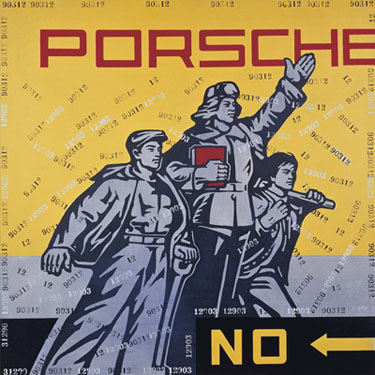beating a dead horse
Ok, not to resurrect the most tired debate in the humanities, but... What's with this whole Modernism -> postmodernism continuum anyway?
More specifically: I have always thought of these and other major movements as culturally relative. Even as globalism spreads, it seems that the rise and form of Modernism and postmodernism in different regions has everything to do with local conditions. Yes, European Modernism influenced the development of late or American Modernism, but what makes them distinguishable has something to do with the circumstances of the different cultures from whence they came.
Thus, I never though of either movement as universally inevitable. It doesn't make sense to me to say that as "developing" nations industrialize there will necessarily be a Modernism and a postmodernism. With different cultural and historical backgrounds and different (and much more rapid) conditions of industrialization, it seems that these artists might develop work that deserves a name of its own. Of course there is influence from the industrialized Western sphere. Artists adopt, parody, integrate, and transform almost everything they interact with. But that does not meld them with their Western counterparts.

Wang Guangyi, "Porsche" 2004
I'm reading New China, New Art by Richard Vine. In the section on painting, speaking of the problematic relationship between Chinese art and Modernism, he writes
It is impossible to deny, looking at works like Porsche, that there is a relationship between American and European postmodernism and the visual language of this new Chinese art. (Obviously there is brand crossover.) But it is the absorption of influence into its own terms. As Vine writes in his introduction
Are these elements not unique enough? Can I really accept Vine's assumption that Western culture has so deeply and globally entrenched itself that all post-Industrial art making is subsumed under the umbrella of Modernism and postmodernism? Then again, the mere fact that contemporary Chinese artists are working heavily in cultural pastiche, a mashing-up de- and re-construction of an increasing flood of imagery and ideas, suggests an inescapable postmodernism.
Modern and postmodern. Perhaps I'm just chafing at how undefined are these terms that have such a chokehold on analytical language.
More specifically: I have always thought of these and other major movements as culturally relative. Even as globalism spreads, it seems that the rise and form of Modernism and postmodernism in different regions has everything to do with local conditions. Yes, European Modernism influenced the development of late or American Modernism, but what makes them distinguishable has something to do with the circumstances of the different cultures from whence they came.
Thus, I never though of either movement as universally inevitable. It doesn't make sense to me to say that as "developing" nations industrialize there will necessarily be a Modernism and a postmodernism. With different cultural and historical backgrounds and different (and much more rapid) conditions of industrialization, it seems that these artists might develop work that deserves a name of its own. Of course there is influence from the industrialized Western sphere. Artists adopt, parody, integrate, and transform almost everything they interact with. But that does not meld them with their Western counterparts.

Wang Guangyi, "Porsche" 2004
I'm reading New China, New Art by Richard Vine. In the section on painting, speaking of the problematic relationship between Chinese art and Modernism, he writes
No wonder experimental artists like Yue Minjun and Wang Guangyi have essentially skipped modernism and plunged directly into postmodern, deconstructive pastiche. (p.31)
It is impossible to deny, looking at works like Porsche, that there is a relationship between American and European postmodernism and the visual language of this new Chinese art. (Obviously there is brand crossover.) But it is the absorption of influence into its own terms. As Vine writes in his introduction
References to Western art were numerous... but certain elements... remained deeply puzzling to non-Chinese viewers. (p.8)
Are these elements not unique enough? Can I really accept Vine's assumption that Western culture has so deeply and globally entrenched itself that all post-Industrial art making is subsumed under the umbrella of Modernism and postmodernism? Then again, the mere fact that contemporary Chinese artists are working heavily in cultural pastiche, a mashing-up de- and re-construction of an increasing flood of imagery and ideas, suggests an inescapable postmodernism.
Modern and postmodern. Perhaps I'm just chafing at how undefined are these terms that have such a chokehold on analytical language.
Labels: art history, china, contemporary, modern, postmodern


0 Comments:
Post a Comment
<< Home